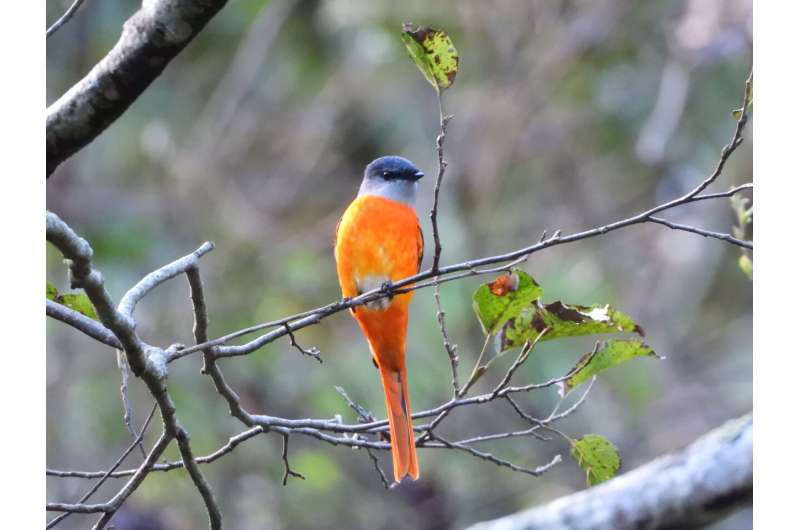The Gray-chinned Minivet displays a secondary non-breeding season peak, which is possibly related to flocking behavior. Credit: Shih-Hung Wu, Ph.D. Candidate
Montane forests, known as biodiversity hotspots, are among the ecosystems facing threats from climate change. To comprehend potential impacts of climate change on birds in these forests, researchers set up automatic recorders in Yushan National Park, Taiwan, and developed an AI tool for species identification using bird sounds. Their goal is to analyze status and trends in animal activity through acoustic data.
Prof. Hsueh-Wen Chang and Ph.D. Candidate Shih-Hung Wu from National Sun Yat-Sen University, Taiwan, Dr. Ruey-Shing Lin, Assistant Researcher Jerome Chie-Jen Ko from the Endemic Species Research Institute, and Ms. Wen-Ling Tsai from Yushan National Park Headquarters have published a paper in Biodiversity Data Journal, detailing their use of AI to detect 6 million bird songs.
Compared to traditional observation-based methods, passive acoustic monitoring using automatic recorders to capture wildlife sounds provides cost-effective, long-term, and systematic alternative for long-term biodiversity monitoring. The authors deployed six recorders in Yushan National Park, Taiwan, a subtropical montane forest habitat with elevations ranging from 1,200 to 2,800 meters.
From 2020 to 2021, they recorded nearly 30,000 hours of audio files with abundant biological information. However, analyzing this vast dataset is challenging and requires more than human effort alone.
The sound of the Gray-chinned Minivet. Credit: Ph.D. Candidate Shih-Hung Wu
To tackle this challenge, the authors utilized deep learning technology to develop an AI tool called SILIC that can identify species by sound. SILIC can quickly pinpoint the precise timing of each animal call within the audio files. After several optimizations, the tool is now capable of recognizing 169 species of wildlife native to Taiwan, including 137 bird species, as well as frogs, mammals, and reptiles.
An automatic recorder was installed on a tree to capture the surrounding soundscape. Credit: Ph.D. Candidate Shih-Hung Wu
In this study, authors used SILIC to extract 6,243,820 vocalizations from seven montane forest bird species with a high precision of 95%, creating the first open-access AI-analyzed species occurrence dataset available on the Global Biodiversity Information Facility. This is the first open-access dataset with species occurrence data extracted from sounds in soundscape recordings by artificial intelligence.
The dataset unveils detailed acoustic activity patterns of wildlife across both short and long temporal scales. For instance, in diel patterns, the authors identify a morning vocalization peak for all species. On an annual basis, most species exhibit a single breeding season peak; however, some, like the Gray-chinned Minivet, display a secondary non-breeding season peak, possibly related to flocking behavior.
As the monitoring projects continue, the acoustic data may help to understand changes and trends in animal behavior and population across years in a cost-effective and automated manner.
Spectacular subtropical montane forest scenery in Yushan National Park. Credit: Ms. Wen-Ling Tsai
The authors anticipate that this extensive wildlife vocalization dataset will not be valuable only for the National Park's headquarters in decision-making. "We expect our dataset will be able to help fill the data gaps of fine-scale avian temporal activity patterns in montane forests and contribute to studies concerning the impacts of climate change on montane forest ecosystems," they say.
More information: Shih-Hung Wu et al, An acoustic detection dataset of birds (Aves) in montane forests using a deep learning approach, Biodiversity Data Journal (2023). DOI: 10.3897/BDJ.11.e97811
Journal information: Biodiversity Data Journal
Provided by Pensoft Publishers


























